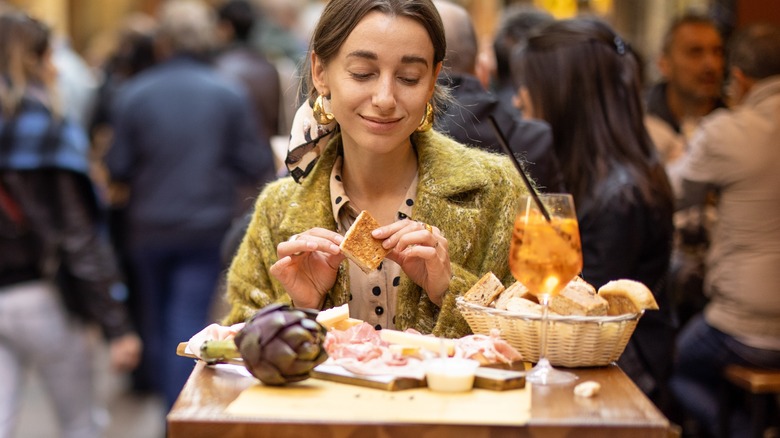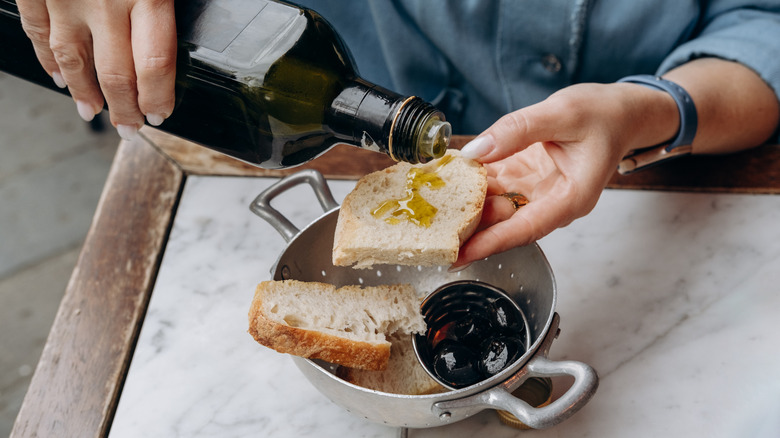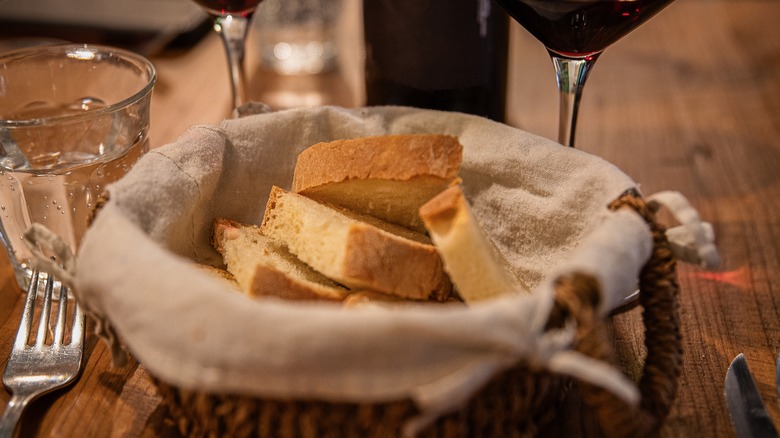The Popular Additions To Bread Tourists Shouldn't Expect To Get At Restaurants In Italy
Italy is, in many ways, a land of carbohydrates. Pasta, pizza, panzerotti, paninis, and, of course, the bread itself. Italian bread, whether a crusty loaf of ciabatta, a slice of focaccia, or a basket of grissini (breadsticks), is often served as a prelude to the meal. However, there are some popular additions to bread that many tourists might expect but won't typically find at restaurants in Italy. If you ask for them — which you should not do when traveling in Italy — the alarm bells will go off, and you will be declared a tourist. Butter? Olive oil and balsamic? Garlic bread? If you want to look like a local, say goodbye to those because they are not a thing in Italy.
In many parts of the world — especially in North America — it's customary for bread to be served with butter in neat little tubs. However, in Italy, you'll rarely, if ever, see butter on the table alongside your bread. Bread and butter don't go together as a pre-meal snack. Instead, butter is reserved for cooking, particularly in Northern Italy, where it's used in dishes like risotto or to enrich sauces. The reason for this lies in Italy's notoriously fussy culinary philosophy, which emphasizes simplicity, locality, seasonality, and, more importantly, allowing the natural flavors of ingredients to shine. Fresh, high-quality bread is considered delicious on its own, with no need for the rich, heavy addition of butter. Only a tourist trap would serve butter and bread in Italy, so watch out!
No butter, no olive oil, and certainly no garlic bread
There is a strange Mandela Effect: everyone (outside of Italy, that is) seems to believe that Italians eat their bread with olive oil and balsamic vinegar. This false memory, a cultural mis-projection if you will, is not traditionally Italian at all. The bread-oil-vinegar combo is a common expectation among tourists traveling to Italy, particularly those from the United States. In some Italian restaurants abroad, it's typical to see a dish of extra virgin olive oil with drops of balsamic vinegar — which you can dress with salt and pepper to taste — served alongside bread for dipping. Sadly, it's not a thing in the motherland. Olive oil is a staple ingredient that gets drizzled over dishes like Caprese salad, bruschetta, or spaghetti aglio e olio, but it's not customarily provided for bread dipping before a meal.
That said, you may encounter olive oil with bread in a few specific contexts, such as a high-end restaurant offering a tasting of regional olive oils or in an agriturismo (farm stay) showcasing the farm's own oil. In a typical Italian trattoria or osteria, don't be surprised if the bread arrives without any dipping sauce. Garlic bread is another Italian-American invention, like spaghetti and meatballs, that you will not find in a traditional Italian restaurant. The closest Italian equivalent would be a bruschetta, fettunta, or standard focaccia. These dishes celebrate the freshness of the ingredients rather than overpowering the bread with butter and garlic.
A bread basket without fanfare: What do you do?
You might ask, what's the point of bread in an Italian restaurant at all? Don't send back that basket just yet — it's not a scam or a money grab. For Italians, bread is a fundamental part of the meal, meant to complement rather than compete with the other dishes. It's used to sop up the flavorful remnants of sauces and broths, a practice known as "fare la scarpetta" or "make a little shoe" (how cute!). However, it is not customary to eat bread with pasta. This particular approach to bread is all about enhancing the overall dining experience rather than enjoying the bread as a separate, heavily seasoned item. Plus, it saves you the embarrassment of licking the plate after a delicious meal. Just use the bread!
Bread is typically served in a simple basket or brown bag without much ceremony. The type of bread does differ, however, depending on the region. In Tuscany, for example, you'll get pane toscano (Tuscan bread), which is famous for its lack of salt — Stanley Tucci warns tourists against eating this cardboard-tasting bread on its own, so beware. The Emilia-Romagna region serves piadina Romagnola, a type of flatbread that has been awarded Protected Geographical Indication status. In Puglia, you'll probably get a focaccia Barese, a focaccia made with semolina, wheat flour, and potatoes, topped with tomatoes and olives. Instead of seeking out familiar additions, try enjoying bread the Italian way.


